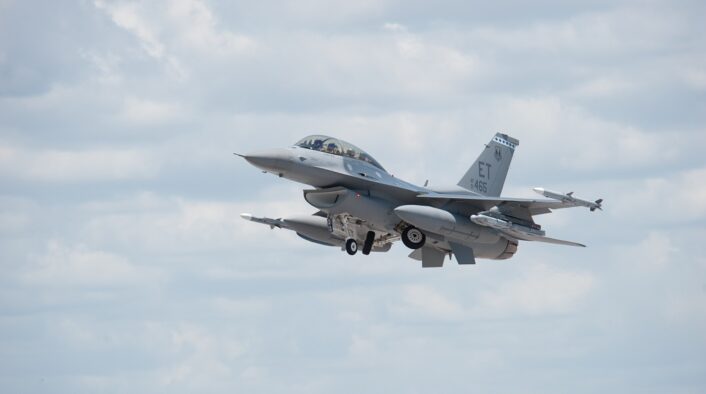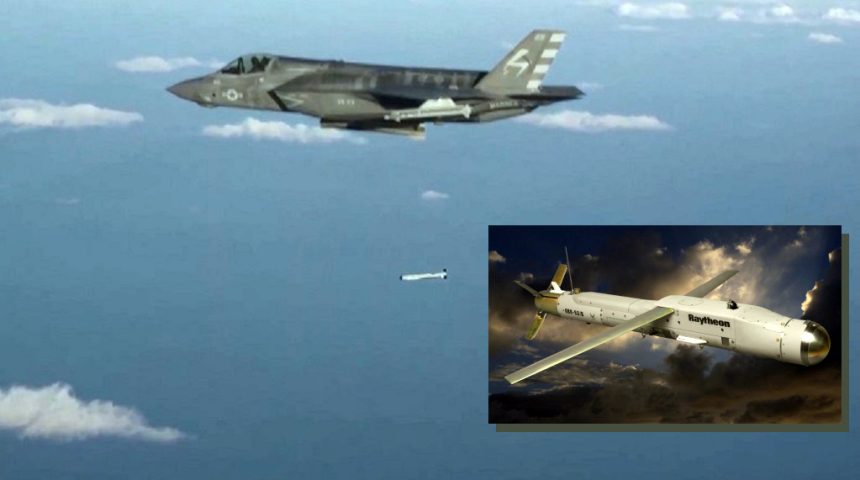During the test, a nearby F/A-18F demonstrated the network connectivity capability by monitoring the weapon until the impact.
Few days after publishing a news feature about the GBU-53/B StormBreaker in which it was announced the first drop by an F-35 Lightning II, Raytheon released more details about the test flight. While the company did not specify how long ago the test happened, they mentioned that it was performed in late 2021 by the U.S. Navy with the weapon being released by a U.S. Marine Corps F-35B assigned to Air Test and Evaluation Squadron Two Three (VX-23).
The press release mentions that, as part of the test, the naval aviator flying the F-35B “used the network-enabled weapon as a guided munition, following the same method one would use in combat, from mission planning to release”. After the weapon release, a nearby F/A-18F Super Hornet monitored the behavior of the weapon over a common network until the successful impact, demonstrating a successful network connectivity capability.
In a previous feature, Raytheon stated that the networking capabilities are one of the key benefits of the StormBreaker. This capability is intended to give an aircraft the possibility to drop the weapon and then hand off its controls to another aircraft connected to the same network. This is considered critical for a JADC2 (Joint All Domain Command and Control) battlespace environment as the U.S. military aims to connect sensors, platforms and weapon systems for multi-domain operations.
“The weapon’s operational flexibility increases the F-35’s capability and capacity, and it helps limit the time our warfighters spend in harm’s way,” said Alison Howlett, StormBreaker program director at Raytheon Missiles & Defense. “StormBreaker allows pilots to hit moving targets in adverse weather conditions, which our adversaries have relied on in the past to avoid detection.”
The GBU-53/B, also known as Small Diameter Bomb II, is planned to continue developmental and then operational testing to prove out safety and capability of the weapon when employed by the F-35. The SDB II is scheduled to complete the integration on all F-35 variants by 2023. The integration on the F-35B could be the most sensitive, as in 2015 it emerged that during initial fit checks the BRU-61/A four-bomb weapon rack could not fit inside the weapon bays of the STOVL variant, requiring a redesign of a hydraulic line and a structural bracket to be rolled out with the Block 4 upgrade. To address this problem, the US Navy is also developing a Joint Miniature Munitions rack.

The U.S. Navy will declare initial operating capability of the GBU-53/B StormBreaker on the Super Hornet after operational testing concludes in 2022. The U.S. Air Force cleared the weapon on the F-15E Strike Eagle in 2020, making it the first aircraft able to carry the weapon. The Air Force and Raytheon dropped 14 StormBreaker smart weapons in the 2021 Weapons System Evaluation Program, continuing the evaluation and tactics development to paves the way for operational use by combat air forces.
As for the F-35, it will be able to carry eight StormBreaker weapons internally and eight externally, providing the 5th gen. aircraft with the capability to hit moving targets in adverse weather, addressing a wide range of threats and scenarios. Further versatility is added by the multi-effects warhead, which is equipped with shaped charge jets, fragmentation and blast charge effects, and an option for a delayed smart fuze. The total weight of the weapon is just over 200 pounds, with half of it being the warhead alone.
“It packs a big punch. The multi-effects warhead really separates this air-to-surface weapon from its predecessor and other munitions in its class”, said Howlett. “There’s more possible for StormBreaker – options like adding propulsion or swapping out the seeker depending on the mission. The hardware and software can cover a range of threats. It’s a very flexible weapon – one-of-kind with world class technology.”
Another key feature of the GBU-53/B is its tri-mode seeker that employs imaging infrared and millimeter wave radar to see through fog, smoke and rain as the weapon glides over 45 miles to strike both fixed or moving targets on land or at sea. The other modes available for target acquisition are the more common semi-active laser homing and GPS/INS guidance.









